Intro
LLMO (Large Language Model Optimization) is the new SEO for an AI-driven world. For years, SEO was about climbing to #1 on Google—but that playbook is changing fast. Tools like ChatGPT, Bing Chat, and Google’s Search Generative Experience (SGE) are now where users get their answers, insights, and recommendations.
As this shift accelerates, brands need visibility both in search results and inside the AI-generated answers. Wellows, an AI search visibility platform, helps teams understand how large language models interpret, reference, and prioritize their content across generative search environments.
By tracking citations, sentiment, and competitive gaps across tools like ChatGPT, Perplexity, Gemini, and Google AI Overviews, Wellows turns AI visibility into signal, which enables brands to identify where they are being recognized, where they are missing, and how to build authority in AI-driven search.
To stay competitive, you need more than SEO. You need LLMO, Answer Engine Optimization (AEO), and other emerging strategies aimed at boosting brand recognition. This guide shows what it is, why it matters in 2025, and how to make your site AI-friendly.
What is LLMO?
LLMO stands for Large Language Model Optimization. It’s the practice of structuring and writing your content so it's easier for AI tools like ChatGPT, Bing Chat, and Google SGE to find, understand, and cite in their generated answers.
While SEO strategies focus on helping your page rank in search results, LLMO is about making your content clear, credible, and easy for language models to summarize in response to user questions. Instead of showing a list of pages, these tools create answers on the spot—using what they’ve already learned plus fresh content from the web.
SEO helps users find your page. LLMO helps AI systems summarize your page for users.
These AI tools prioritize content that is well-structured, authoritative, and easy to interpret, especially when responding to complex or high-intent queries. That means your content needs to do more than simply exist—it has to be understood and selected.
Real-world example:
Let’s say your company publishes a detailed breakdown of pricing models for SaaS tools. If the content is organized with semantic headings, includes clear definitions, and cites credible sources, a tool like ChatGPT is more likely to pull from it when a user asks, “What are the most common SaaS pricing models?”
Instead of just ranking on page one, your content could be featured directly in the AI’s response, driving both visibility and trust.
Effective LLMO goes beyond keywords and backlinks. It leans into:
- Semantic structure, like proper use of headings and schema
- Contextual relevance, or how well your content answers the question in context
- Content clarity, avoiding fluff or ambiguity
- Intent alignment, making sure you solve the actual user query
As more users turn to AI for research and decision-making, LLMO adds a critical layer to traditional SEO. Whether someone is comparing B2B platforms or exploring solutions to a niche problem, your goal is to be the source AI pulls from first.
That’s what LLMO aims to achieve.
Why LLMO Matters in 2026
The way people search is changing. More users are turning to AI assistants like ChatGPT and Bing Chat for direct answers, bypassing traditional search engines altogether. This shift is accelerating.
LLMO is important for your brand in case you want it to be visible, cited and trusted as an authoritative business.
1. AI is becoming the new search interface
AI tools are no longer a novelty. For many users, they are the first stop when researching a product, service, or complex question. These tools deliver synthesized responses instead of listing links.
Websites like transformik.com help you find the most relevant AI tools for your needs, enabling marketers, creators, and businesses to stay ahead with the right technology stack.
If your content isn’t optimized to be understood and cited by AI, your brand won’t appear.
Example: When someone asks, “What’s the best CRM for early-stage startups?” tools like ChatGPT won’t point to 10 blog posts, they will mention 2–3 tools by name.
2. Organic traffic is declining
Google’s AI Overviews reduced the need to click through. Ahrefs reports CTRs for top-ranking results dropped by over 34%. Fewer clicks mean fewer visits, even for sites that rank first. LLMO helps regain visibility by aiming for inclusion in AI-generated answers.
3. AI recommendations build trust
Users often see AI answers as credible and unbiased. Being cited in a generated response gives your brand implied authority, similar to being featured in a top publication.
4. First movers shape future results
LLMO is new, so early adoption creates an edge. Once a model associates your brand with a topic, like "open-source analytics platforms," that connection often persists.
5. SEO and LLMO are complementary
LLMO builds on strong SEO fundamentals. Clear site architecture and well-structured content make it easier for AI systems to understand and cite your material. LLMO adds the goal of helping content surface in AI answers, not just ranked lists.
Takeaway: LLMO isn’t optional. It’s already reshaping how people find and evaluate brands online.
How LLMs Find and Use Content
To make your content AI-friendly, it helps to know how these tools come up with their answers. These systems don’t operate like traditional search engines. They rely on static training data, real-time retrieval, or a mix of both.
1. Static Training Data
Many LLMs are trained on massive datasets that include public web pages, forums, Wikipedia, and other open-access sources. If your content existed during the model’s training period and was well-linked or frequently cited, it may already be part of the LLM’s memory.
The limitation? This memory does not update automatically. If the model hasn’t been retrained since your content was published, it won’t know your material exists.
2. Retrieval-Augmented Generation (RAG)
Some systems, like Bing Chat and Perplexity, combine static training data with real-time web retrieval. These models can fetch up-to-date information from live websites and often cite sources directly in their responses.
For these tools, strong SEO remains essential. Your page needs to rank and be indexable to have any chance of being referenced.
In both cases, AI systems prioritize:
- Clarity: Is your content structured and easy for machines to process?
- Authority: Are you cited on other reputable websites?
- Relevance: Does your page directly answer the question a user might ask?
- Structure: Can an answer be extracted cleanly from a specific section or paragraph?
Being featured in AI-generated results isn’t only about visibility. Your content must also be clear, credible, and easy for AI systems to interpret and reference. This is where LLMO makes the difference.
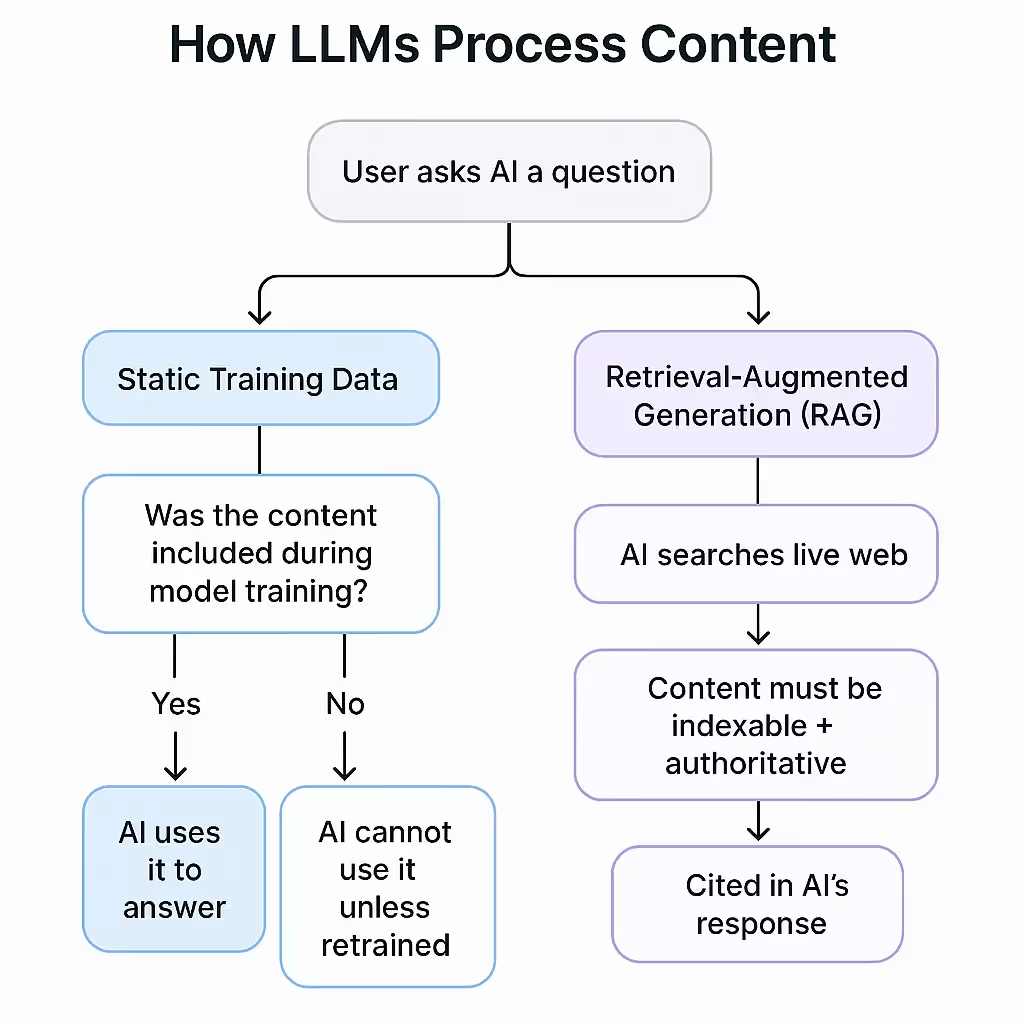
LLMO vs Traditional SEO
In simple terms, SEO gets you found. LLMO gets you selected. With that said, they operate differently and prioritize distinct factors.
1. Search Results vs Single Answers
SEO focuses on ranking in search results where users choose from multiple links. LLMO aims for your content to be selected and summarized by AI, often as the only answer presented.
2. Keywords vs Semantics
SEO revolves around targeted keywords. LLMO prioritizes context and meaning, looking at how your content fits into broader topics and relationships.
3. Link Signals vs Credibility Signals
SEO relies on backlinks and internal links. LLMO considers citations in training data and trusted datasets, favoring content that is authoritative and factually consistent.
4. Snippet Optimization vs Passage Understanding
Search engines pull featured snippets. LLMs scan entire sections to build answers. Breaking your content into clear, standalone chunks makes it more likely to get picked up.
5. Indexing vs Training
SEO depends on crawling and indexing. LLMs use training data or pull live information in real time. Your content must either be in training sets or rank high enough for retrieval.
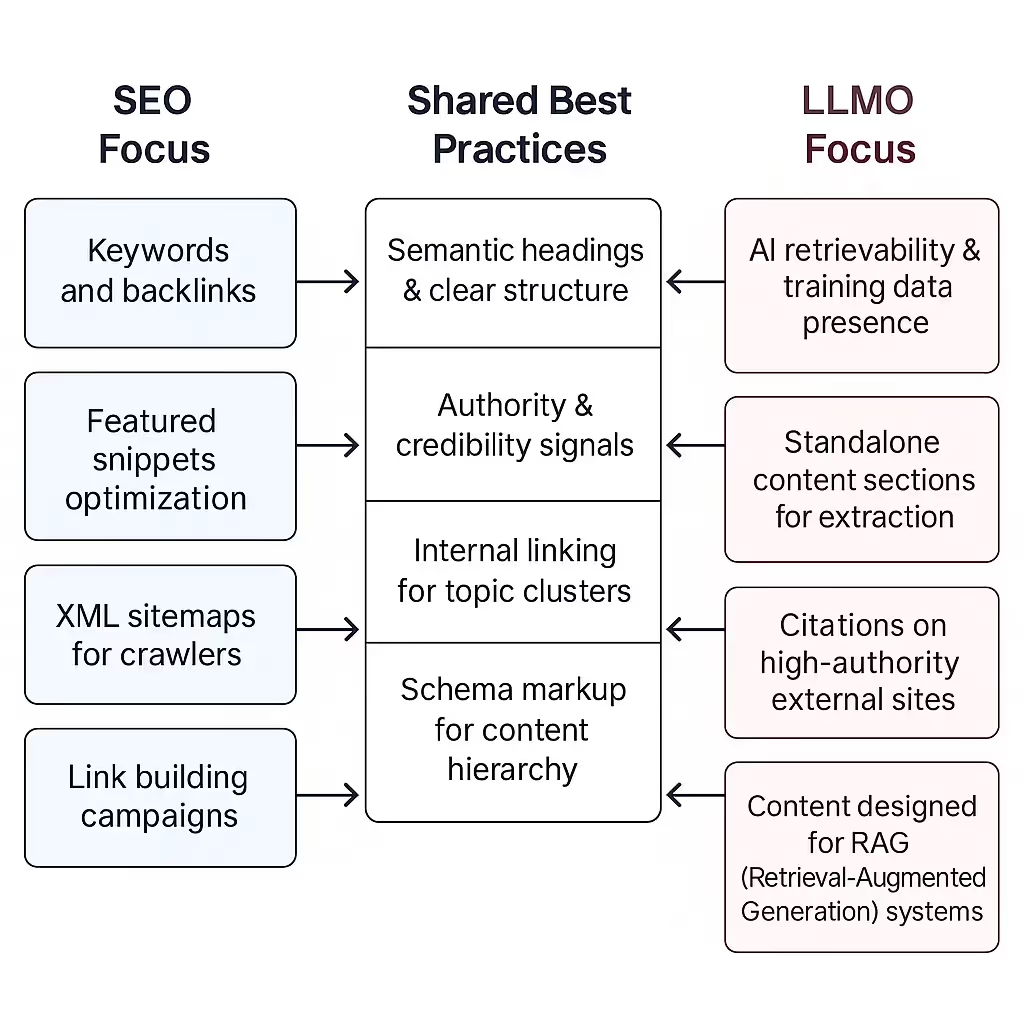
LLMO Content Strategy: Best Practices
Optimizing content for LLMs requires writing for both humans and machines. You need to communicate clearly, deliver value, and make it easy for AI systems to extract relevant information. This section outlines best practices, starting with how to structure your content for AI.
Structure for AI Readability
AI models don’t browse websites like humans do. They interpret and summarize content. The more structured and consistent your content is, the easier it becomes for AI to parse and reuse in generated answers. A new protocol called llms.txt even allows webmasters to provide a curated summary of their site for AI models – we cover how to implement it in our guide.
Tips for structuring content:
- Use clear H2 and H3 headings to break down topics
- Open sections with short summaries or definitions
- Keep sentences concise and paragraphs focused
- Use lists or tables to present related facts or steps
Well-organized content helps humans scan quickly and allows LLMs to identify distinct ideas or answers without confusion. Each subsection should feel self-contained, like a mini-answer that could stand alone.
Example:
An article titled “Top SaaS Pricing Models Explained” that includes clear headings for each model, concise descriptions, and a comparison table is more likely to be cited by ChatGPT when a user asks, “What are common SaaS pricing strategies?”. A long, unstructured post covering the same topic would be harder for AI to parse and summarize effectively.
Next, let’s look at how to align your topics and writing with the way AI understands meaning, not just keywords.
Why TL;DR Summaries and FAQs Work for LLMO
After structuring your content for AI readability, two simple tactics can give it an extra edge: TL;DR summaries and FAQs.
TL;DR summaries provide a concise overview at the top of a page. This benefits both users and AI systems by:
- Making key insights scannable in seconds.
- Helping language models extract clean, high-level answers.
FAQs are equally powerful. By breaking down content into clear question-and-answer pairs, you make it easier for AI tools to identify and cite specific answers. This structure is particularly effective for long-form guides where readers—and machines—are looking for precise information.
Both approaches improve usability for humans while boosting your chances of being referenced in AI-generated responses.
Focus on Topics, Entities, and Semantics
LLMs do not rely on keywords alone. They process meaning, context, and relationships between concepts. To improve your chances of being cited, your content needs to align with how AI models group and understand information.
How to align with LLMs effectively:
- Write topically rich content: Cover your subject in depth, including subtopics, examples, and practical use cases.
Use related terms and synonyms: AI links phrases like “lead scoring,” “pipeline optimization,” and “sales efficiency.” Avoid repeating the same keywords excessively and let the language flow naturally. - Reference well-known entities: Mention tools, frameworks, brands, or experts in your industry. These provide context and help AI systems interpret your content accurately.
- Use topic clusters: Organize related pages under core themes and link them internally. This helps AI recognize your site as an authority in that space.
Build Authority Through Credibility Signals
AI systems prefer content that shows clear expertise and trustworthiness. This isn’t just about sounding authoritative, it’s about providing information that is verifiable and aligns with E-E-A-T (Experience, Expertise, Authority, Trust).
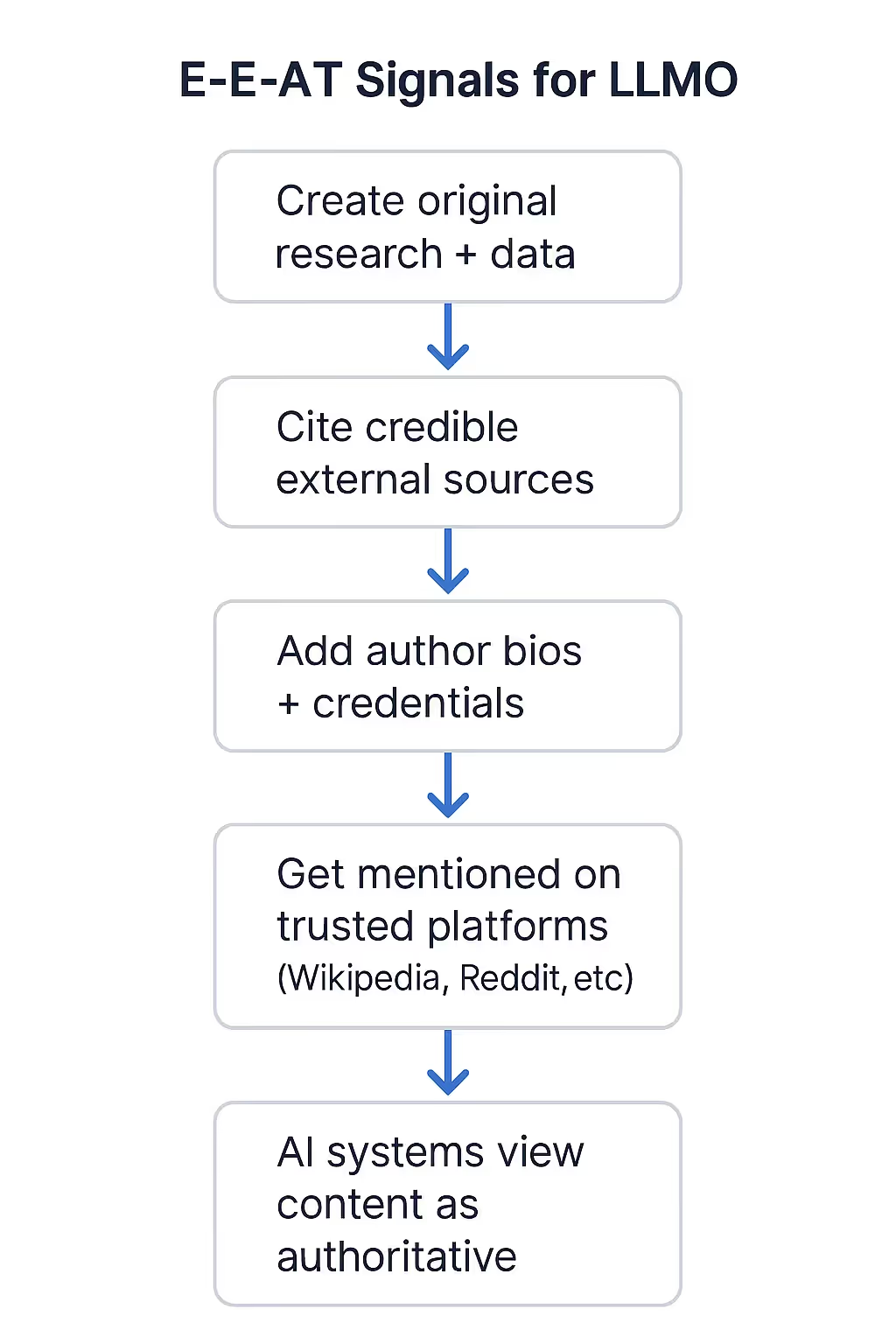
How to establish authority:
- Cite reputable sources: Reference studies, data, and research from trusted organizations.
- Publish original data: Proprietary insights or case studies make your content stand out and increase its likelihood of being cited.
- Add author bios and bylines: Show who created the content and their qualifications.
- Avoid unsupported claims: Unverified statements reduce credibility for both users and AI.
- Refresh your content regularly: Outdated information weakens trust. Update statistics, examples, and references to stay relevant.
LLMs prioritize clear, credible content. Posts with strong authorship and well-documented sources are far more likely to be selected for AI-generated answers.
Align With SEO Fundamentals
While LLMO introduces new priorities, it does not replace SEO. Instead, it builds on it. Many practices that help search engines discover and rank your content also improve its visibility to AI systems.
Key SEO practices that support LLMO:
- Improve crawlability: Ensure important pages are indexable and not hidden behind JavaScript or login walls.
- Use schema markup: Add FAQ, How-To, or Article schema. While not all AI systems process it directly, it improves search visibility and increases your chances of being cited.
- Optimize for featured snippets: These often appear in AI-generated answers. Use concise responses, question-style headings, and bullet points to make your content snippet-ready.
- Maintain fast, mobile-optimized pages: A smooth user experience keeps your site competitive and ensures AI tools with real-time retrieval can access your content.
- Link relevant internal content: Strengthen topical authority with a network of related pages. This helps AI systems view your site as a trusted source in your niche.
If you are already investing in SEO, much of your foundation is in place. LLMO adds another layer of focus: ensuring your content is interpreted and cited by AI, not just clicked on in search results.
Get Cited in AI-Visible Sources
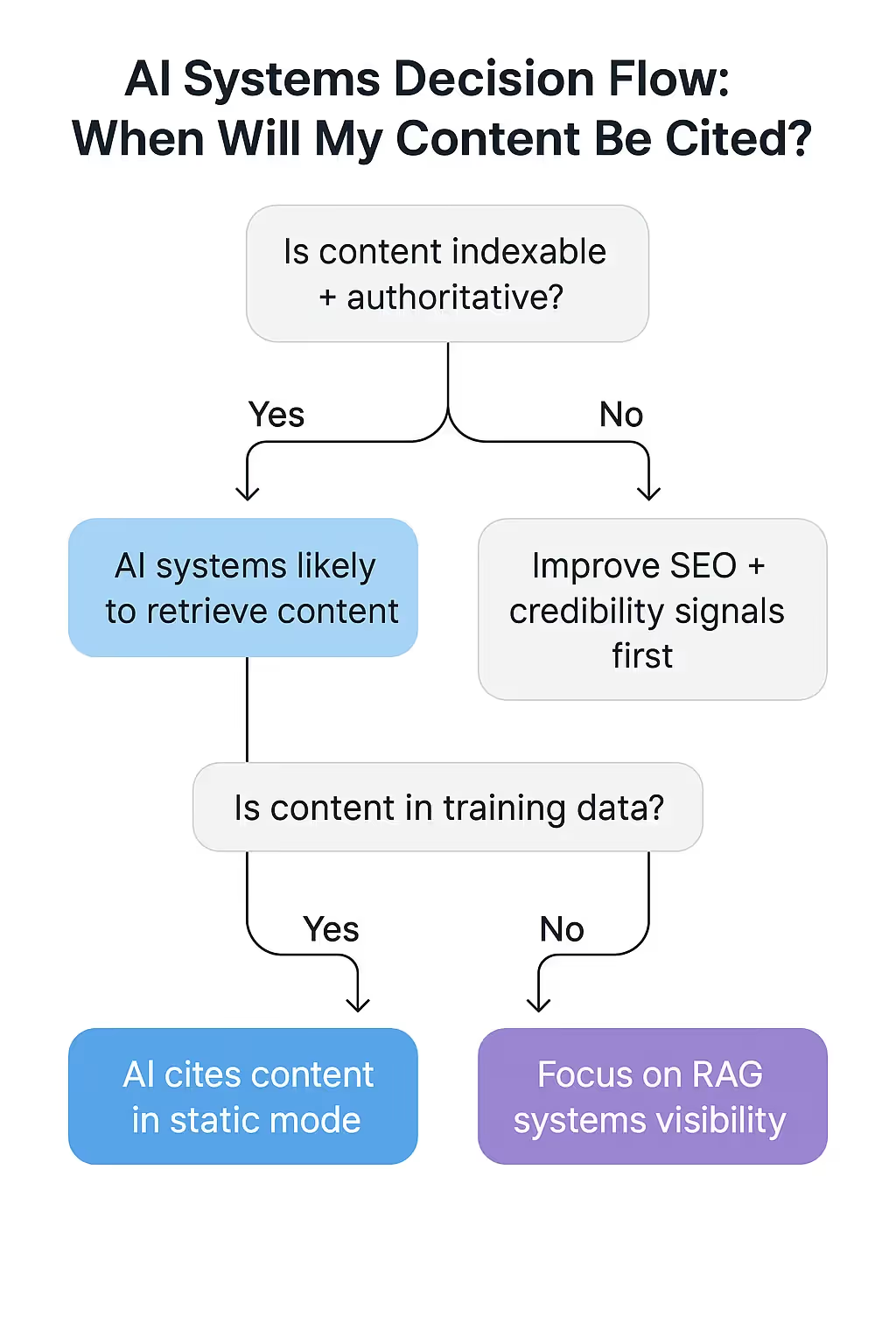
LLMs are trained on massive web datasets. Influential sources include Wikipedia, Reddit, Quora, public blogs, and news media. If your brand appears on these platforms, it is more likely to be included in training data or retrieved in real-time answers.
Tactics to expand off-site visibility:
- Contribute to expert Q&A platforms: Write helpful, non-promotional responses on Reddit or Quora that reference your expertise or content.
- Pitch guest posts: Publish articles on high-authority sites in your industry. Prioritize platforms with strong readership and credibility.
- Pursue digital PR: Secure mentions in roundups, opinion pieces, or industry features. Co-citations with well-known brands increase your relevance.
- Document your brand: Maintain a Wikipedia entry or profiles on trusted knowledge bases if possible.
Example:
A productivity SaaS tool mentioned in a popular Quora thread about “Best apps for remote teams” is more likely to be cited in ChatGPT’s answer when users ask for recommendations.
These placements do more than drive traffic. They signal to LLMs that your brand is active, authoritative, and relevant in its field. Over time, this builds semantic weight and raises your chances of being cited in AI-generated answers.
Track, Test, and Iterate
LLMO is still a new and evolving space, so you won’t always get immediate feedback. However, you can monitor key indicators and adjust your strategy over time.
Ways to measure LLMO impact:
- Monitor AI referrers: Tools like Perplexity and Bing Chat may appear in your referral data. Track visits from these sources in your analytics platform.
- Use AI prompt testing: Regularly test prompts in ChatGPT, Claude, or similar tools to see if your content or brand is mentioned. Track results manually or with scripts.
- Survey your audience: Add a field like “How did you find us?” to forms, with options such as “ChatGPT” or “AI assistant.” This helps capture insights that analytics might miss.
- Watch brand mentions: Use platforms like Ahrefs, Mention, or Semrush to find citations, even unlinked ones, on forums and third-party sites.
- Review traffic trends: AI citations can lead to indirect search traffic. Look for spikes or patterns in branded search queries.
Example:
A B2B SaaS company noticed a surge in branded search queries after their product guide was cited in Perplexity’s AI-generated answers. By tracking these mentions, they identified which topics resonated and created additional content in the same cluster.
LLMO is not a one-time checklist. It’s an ongoing process that rewards clarity, authority, and consistency. Focus on what works, and double down on formats and topics that AI systems pick up.
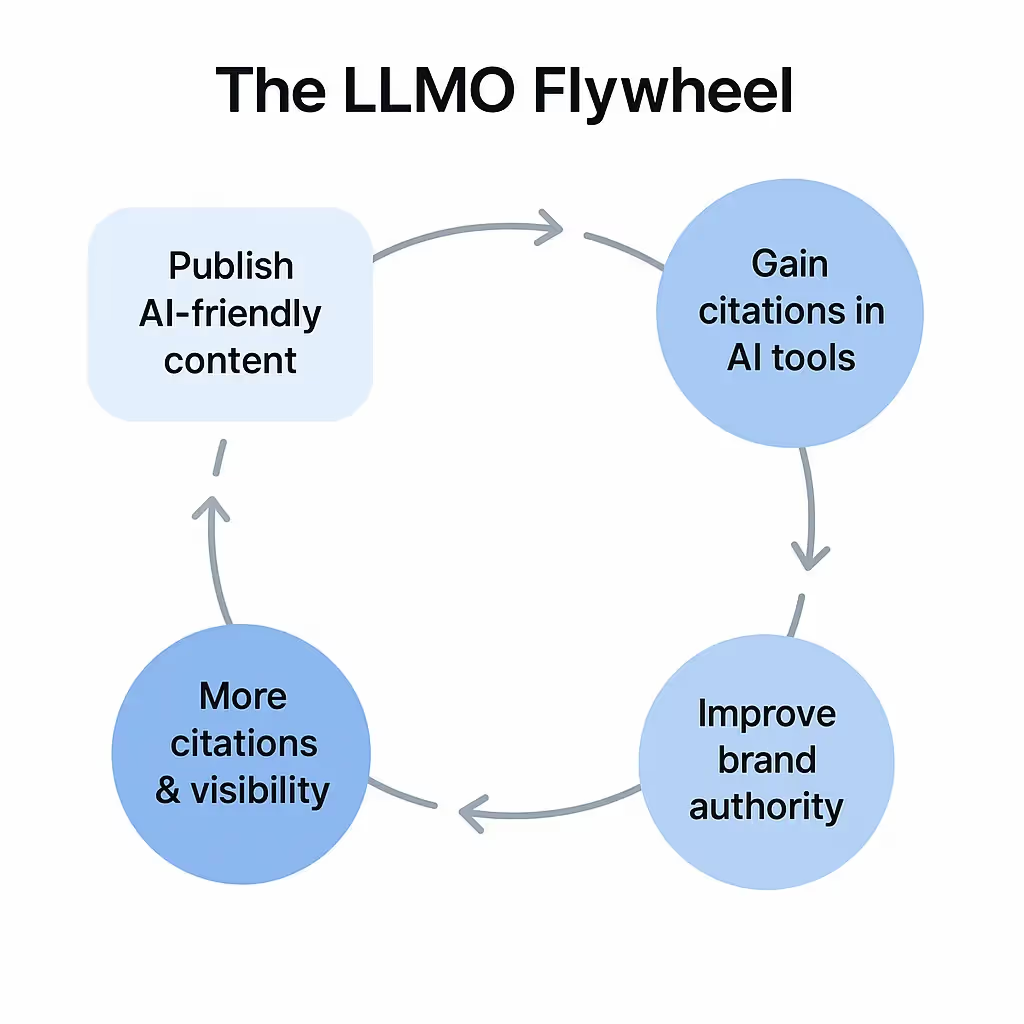
What to Avoid in LLMO
Not every tactic promoted as LLMO is effective or ethical. Just as with early SEO, there is a temptation to manipulate systems that are not yet fully transparent. However, AI companies are improving their models quickly, and short-term gains from questionable tactics often lead to long-term harm.
Content stuffing or repetition
Filling pages with excessive keywords or synonyms does not help and can cause your content to be ignored. AI models detect patterns easily, and repetitive content is often flagged as low-quality or manipulative.
Invisible or misleading text
Hiding AI-targeted keywords in white-on-white text or invisible divs is an outdated black hat tactic. It is detectable and damages trust in your content.
Low-quality AI-generated content
Producing large volumes of AI-generated text without proper editing creates vague, unhelpful pages. If you use AI tools for drafting, ensure every piece is fact-checked, refined, and tailored to your audience.
Fake citations or authority claims
Fabricating statistics, testimonials, or source quotes may seem like a shortcut to credibility but often backfires. It undermines trust and risks your brand being flagged in AI training datasets.
Over-promising reach
Be cautious of vendors promising to “get you into ChatGPT” or “inject your brand into AI answers.” LLMO is about building real authority and discoverability, not gaming the system.
A simple rule: If you wouldn’t use the tactic for human readers, don’t use it for LLMs. LLMO works best when it focuses on clarity, accuracy, and integrity. The goal is to have AI recommend your content because it genuinely deserves to be cited.
Conclusion: LLMO Is Not Optional
AI-generated answers are reshaping how users discover and choose brands—and the shift is accelerating. Large Language Model Optimization (LLMO) is the response to this shift. It ensures your content is not only searchable but also selectable by the systems guiding user decisions.
To summarize:
- LLMO does not replace SEO, it builds on it.
- Clarity, credibility, and semantic structure matter more than keyword tricks.
- Getting mentioned on other trusted sites is just as important as what’s on your own.
- Tools like ChatGPT, Bing, and Google SGE are already influencing traffic, even if you don’t see it yet.
The longer you wait to adapt, the harder it will be to build relevance in LLM outputs. With the right foundation, LLMO is not a leap, it’s a refinement.
The brands that win in the AI era will be the ones AI tools cite first. Let’s make sure that’s you.
We are an experienced SEO agency for tech startups that understands both the mechanics of modern search and the nuances of AI-driven visibility. Reach out to see how we can help you lead the conversation, not get left out of it.
FAQs: Large Language Model Optimization (LLMO)
Does LLMO replace traditional SEO?
No. LLMO builds on SEO fundamentals like crawlability and site structure but focuses on making content AI-friendly so it’s cited in AI-generated answers, not just ranked in search results.
How long does it take to see LLMO results?
It depends. AI systems with real-time retrieval (like Bing Chat) can reflect changes within weeks, while static LLMs (like GPT models) require retraining before visibility improves.
Can I optimize existing content for LLMO, or do I need to create new pages?
Both. Refresh old pages with better structure and semantic markup, and publish new AI-focused content on trending topics.
How is LLMO different from featured snippets optimization?
Featured snippets target Google search results, while LLMO focuses on helping AI tools synthesize answers from multiple sources, requiring stronger context and authority signals.
Is there a robots.txt equivalent for LLMO?
An llms.txt file is an emerging standard to instruct AI crawlers on which pages to include or exclude from their datasets (similar to robots.txt). Adoption is still developing.
Should I submit XML sitemaps or RSS feeds for LLMO?
Yes. Both make your content easier for AI systems to crawl and fetch updated information. You can read our article on generating a sitemap in Webflow.
Do LLMs like ChatGPT crawl websites directly?
Not directly. Most rely on static training data or APIs. To ensure visibility, your content must either be in their training data or easily retrievable via SEO best practices.
How do I add schema markup for LLMO?
Use structured data like FAQ, How-To, and Article schema to help AI understand your content’s hierarchy. Tools like Google’s Structured Data Markup Helper can assist.
Can LLMO improve performance on voice assistants like Alexa or Google Assistant?
Yes. Structured, semantic content aligns well with how voice assistants deliver precise spoken answers.
What tools can I use to monitor LLMO performance?
Track AI referrers in analytics, test prompts in ChatGPT and similar tools, and use platforms like Ahrefs or Semrush to find AI-related mentions.




